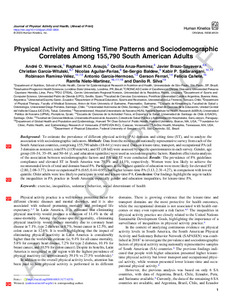Por favor, use este identificador para citar o enlazar este ítem:
https://repositorio.uca.edu.ar/handle/123456789/16392| Título: | Physical activity and sitting time patterns and sociodemographic correlates among 155,790 south american adults | Autor: | Werneck, André O. Araujo, Raphael H.O. Anza Ramírez, Cecilia Brazo Sayavera, Javier García Witulski, Christian Martín Aguilar-Farias, Nicolas Baldew, Se Sergio Sadarangani, Kabir P. Ramírez Vélez, Robinson García-Hermoso, Antonio Ferrari, Gerson Canete, Felicia Nieto Martinez, Ramfis Silva, Danilo R. |
Palabras clave: | EJERCICIO FISICO; DESIGUALDAD; SEDENTARISMO; ACTIVIDAD FISICA; ADULTOS; CALIDAD DE VIDA | Fecha de publicación: | 2023 | Editorial: | Human Kinetics | Cita: | Werneck, A. O. et al. Physical activity and sitting time patterns and sociodemographic correlates among 155,790 south american adults [en línea]. Postprint de artículo publicado en Journal of Physical Activity and Health. 2023. doi: 10.1123/jpah.2022-0305. Disponible en: https://repositorio.uca.edu.ar/handle/123456789/16392 | Resumen: | Background: To estimate the prevalence of different physical activity (PA) domains and sitting time (ST), and to analyze the association with sociodemographic indicators. Methods: Data from the most recent nationally representative survey from each of the Q South American countries, 1 comprising 155,790 adults (18–64 y) were used. Data on leisure-time, transport, and occupational PA (all 3 domains as nonzero), total PA (≥150 min/wk), and ST (≥8 h/d) were assessed by specific questionnaires in each survey. Gender, age group (18–34, 35–49, and 50–64 y), and education (quintiles) were used as sociodemographic factors. Random effect meta-analysis of the association between sociodemographic factors and PA and ST were conducted. Results: The prevalence of PA guidelines compliance and elevated ST in South America was 70.3% and 14.1%, respectively. Women were less likely to achieve the recommended levels of total and domain-based PA. Participants in the highest quintile of education were more likely for elevated ST (2.80, 2.08–3.77), lower occupational PA (0.65, 0.44–0.95), but higher leisure-time PA (3.13, 2.31–4.27), in comparison with lowest quintile. Older adults were less likely to participate in total and leisure-time PA. Conclusion: Our findings highlight the urge to tackle Q the inequalities in PA practice in South America, especially gender and education inequalities, 2 for leisure-time PA. | Cobertura Espacial: | América del Sur | URI: | https://repositorio.uca.edu.ar/handle/123456789/16392 | ISSN: | 1543-3080 (impreso) 1543-5474 (online) |
Disciplina: | SOCIOLOGIA | DOI: | 10.1123/jpah.2022-0305 | Derechos: | Acceso abierto | Fuente: | Journal of Physical Activity and Health. 2023 |
| Aparece en las colecciones: | Artículos |
Ficheros en este ítem:
| Fichero | Descripción | Tamaño | Formato | |
|---|---|---|---|---|
| physical-activity-sitting-time.pdf | 1,24 MB | Adobe PDF |  Visualizar/Abrir |
Visualizaciones de página(s)
52
comprobado en 27-abr-2024
Descarga(s)
29
comprobado en 27-abr-2024
Google ScholarTM
Ver en Google Scholar
Altmetric
Altmetric
Este ítem está sujeto a una Licencia Creative Commons

